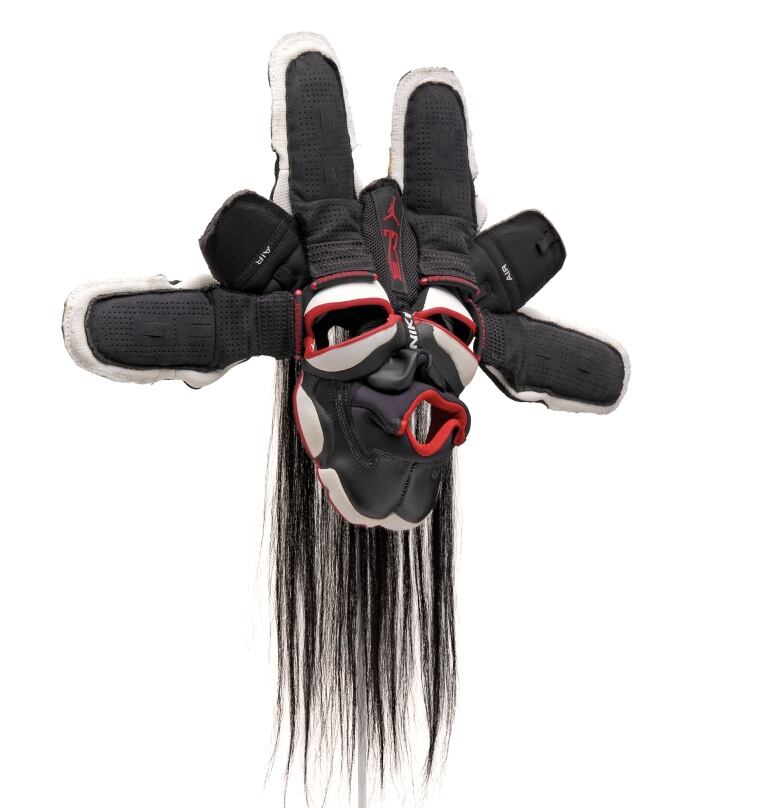How this B.C. artist uses sliced up Air Jordans to connect with his Indigenous roots
Brian Jungen's 20-year career will be on display this summer at the Art Gallery of Ontario

This story was originally published on June 19, 2019.
Indigenous art and Nike Air Jordans have a lot in common, says Brian Jungen.
The B.C. artist from Doig River First Nation is known for transforming everyday objects into extraordinary sculptures, and the iconic basketball shoes are one of his favourite materials to work with.
His fascination began in the '90s on a trip to New York City, when he saw Air Jordans lined up at a Nike store in "museum-like display cases."
"I had actually that same day been at the Museum of Natural History and I saw ... a lot of Indigenous artwork that's kind of still in the realm of the science museum, and that was kind of upsetting to me," Jungen told As It Happens host Carol Off.
"Seeing how ... those objects became fetishized and held up as specimens of nature rather than being put in an art museum, that got me thinking about how other objects are treated in a very different way — like putting sneakers behind glass."
Jungen's life's work will be on display at Toronto's Art Gallery of Ontario in a new exhibit called Brian Jungen: Friendship Centre from June 20 to Aug. 25.
Cutting up Jordans is like 'gutting a salmon'
After New York, Jungen says he started buying Jordans in bulk, taking them home and slicing them up.
It was a strange thing to do, he says, to something that had been an object of desire when he was a teenager.
"I kind of got a bit of an illicit thrill out of cutting them up," he said with a laugh. "They may not have sold them to me if I told them I was going to cut them up."

Initially, he would disassemble the Jordans and take photographs of them. But soon, he started to reassemble them in new ways, creating objects like masks and headdresses that would be familiar to anyone who has seen Indigenous artifacts in a museum.
It marked a turning point in his career when he moved from drawing to sculpting.
"There's a very similar motion that I use with a knife cutting up an Air Jordan that is very similar to, like, gutting a salmon or skinning a moose," he said. "They're skills that are kind of translatable."

That connection between traditional skills and modern art is at play throughout Jungen's 20-year body of work.
After his parents died in a fire when he was seven years old, Jungen was raised by his father's extended Swiss family in B.C. It wasn't until he got older that he began to reconnect with his mother's Dane-zaa family.
"I went through a lot of anguish then and that's something that took me quite a while to get over," he said. "I think a large part of my kind of self-therapy was art and creating my own world."
Golf bags, totem poles and land rights
With his work, Jungen draws parallels between mass-produced commercial objects and Indigenous art — often challenging people's perceptions of both.
His totem poles are crafted from golf bags.
"It's a very dad thing, golf bags," he said. "It really has no bearing on my life."
But golf does have a bearing on Indigenous land rights in this country.

The 1990 Oka Crisis — a tense showdown between Indigenous people, Quebec police and eventually the Canadian army — centred around plans to build a golf course on unceded Mohawk land.
"That's something I first noticed in Vancouver is the kind of disparities between the community whose reserve it belongs to and then the leased-out golf courses," he said. "They are often just right across the street from each other."
Whales and chairs
But Jungen is perhaps best known for his sculpture Cetology.
At first glance, the 6.6-metre long piece appears to be a massive blue whale skeleton — the kind you'd find in a nature museum.
But look closer, and you'll see it's actually made from discarded Canadian Tire lawn chairs meticulously carved to look like bones.

The inspiration, Jungen said, came from learning about how the whale oil that once fuelled cities was eventually replaced by petroleum — the same material found in those cheap, disposable chairs.
"I kept seeing them on the street broken, and you can't fix them once they become this, like, disposable thing that is real tragedy," he said.
"I saw them as being kind of liberated once they were broken and they had a completely new possibility I could work with."
Sport and ceremony
During Jungen's AGO exhibit, the gallery space will be transformed to look like a high school gymnasium.
"I got to thinking about my history — and I guess maybe a collective history of people — with high school gyms," he said.
"It could be a site of, you know, incredible pain for people who you know weren't involved or interested in sports. But it's also a place for a lot of First Nations people that is a site of ceremony, especially for gatherings and dancing."
Called Friendship Centre, the exhibit is named after the Vancouver Aboriginal Friendship Centre Society, where Jungen has spent a lot of time making art.
"I set up a studio that was right behind it and I saw all sorts of different activities in that gymnasium, including basketball games," he said.
"So that's kind of what how that started — and I wanted to create a space in a museum that seemed a bit more kind of welcoming, or a place that possibly a lot of youth could identify with."
Written by Sheena Goodyear. Interview produced by Jeanne Armstrong.